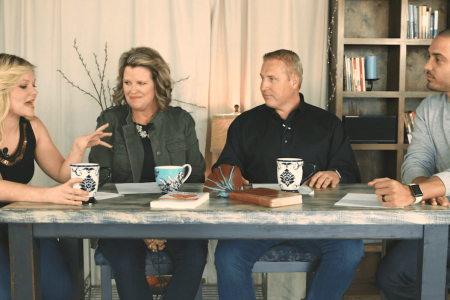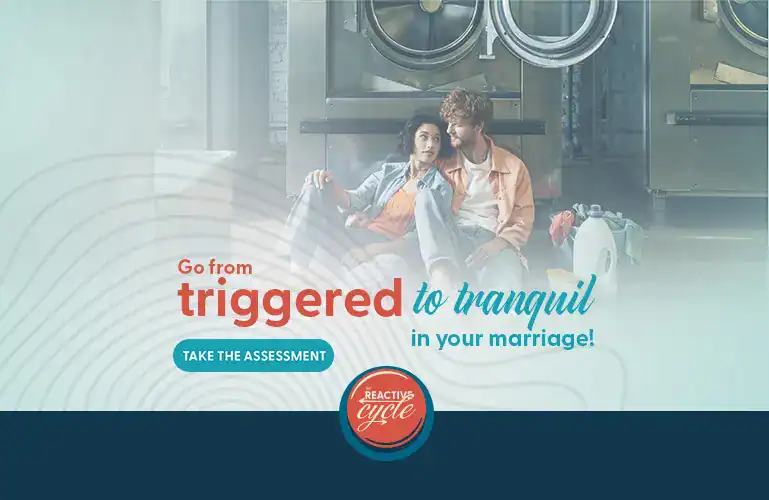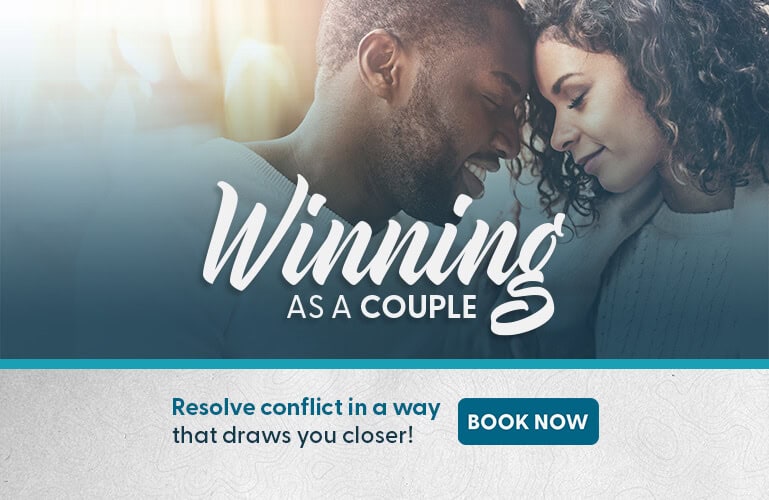Estimated reading time: 7 minutes
Conflict is a common and normal part of married life, but that doesn’t mean we can leave it unresolved. The key to resolving conflict is to open your heart back up to your spouse.
Article at a glance:
- What a “snap” can do to a situation.
A snap is the moment where a normal situation turns into conflict. There are so many ordinary or pleasant situations, that can turn ugly– fast.
- Protect your buttons to dodge conflict.
You understandably get upset when people push your buttons. Nevertheless, you are the one responsible for how you act when those buttons are pushed. Be aware of what is happening inside you when someone pushes your buttons. Break the reactive cycle of conflict.
- Recovering in the middle of conflict.
When you find yourself in the midst of conflict, don’t let it carry you away. Take a moment to cool off, identify your emotions, and discover what’s really going on under the surface.
The Snap
My wife, Erin, our 17-year-old daughter, Murphy, and I were in Japan to present a marriage seminar. We arrived a few days early so we could see some of Tokyo.
One of the can’t-miss attractions was a beautiful park called Meiji Shrine — a sprawling complex filled with ponds, old bridges and seemingly miles of paths. We put that on our itinerary and, in preparation for our daytrip, I researched how to walk there from our hotel, the best paths to take in the park and other details. I planned it perfectly, if I say so myself.
Or so I thought. We lost our way a few times on the way to the park (my fault), and once we arrived, we were pretty exhausted. We walked through the entrance gate and almost immediately came to a fork in the road.
I wasn’t surprised. I’d studied the map and planned on taking the “long way,” which led to a beautiful bridge overlooking a gorgeous pond — perfect selfie location!
But when we arrived at the fork, Erin and Murphy wanted to take the shortest route. So, instead of following me as I turned down the path that I had mapped out, Erin and Murphy started walking the other way.
“You’re going the wrong way,” I told them.
“We’re tired,” they said in unison, “and this looks like the shortest route.”
“But this way is the more picturesque way, and I want to have a family picture by the bridge and pond.”
“But we’re exhausted,” Erin said.
I could feel my blood beginning to boil. “Fine,” I snapped, “let’s go your way.” And I stomped down their route. Not the best way to resolve conflict, I admit.
The Snap’s Consequences
I think Erin and Murphy were stunned by my reaction. Once they realized how important the “scenic” route was, they started walking in that direction — my “planned” route. But I was already huffing and puffing down the shorter path, not even looking back because I was angry with both of them.
Once I realized that they didn’t plan on following me, I really got upset and wanted to “teach them a lesson.” I knew, from my map study, that the paths would eventually merge together. I figured I’d stomp and sulk the “short” way and meet up with the girls later, where they’d grovel and ask my forgiveness.
But when I reached the spot where I figured we’d meet, the girls weren’t there. After waiting a few minutes, I realized something awful: My wife and daughter were lost in the middle of Japan.
I was going to be in big trouble.
Resolve Conflict by Protecting Buttons
When we argue, it’s rarely about what we think it’s about. Surface topics may appear to be what’s driving the conflict, but that’s an illusion. What really happens is that a “button” is pushed — a fight touches on a sensitive topic or a long-hidden wound. We all have buttons throughout our psyches, and boy, is it easy to push them.
These buttons are often deep insecurities: feeling unloved or rejected, abandoned or misunderstood. Our buttons are pushed when we feel like we’re failing. Like we’re failures.
Once a button is pushed, our hearts close instantly. It’s like one of those little roly-poly bugs — they just fold in on themselves and prying them open is difficult.
I’d shut up like a roly-poly in Tokyo. My anger turned to worry quickly, but, after 30 minutes of looking, I finally saw them — exiting Meiji’s main shrine. That shrine was the whole reason we wanted to visit this place. And they’d done it without me. I didn’t care about resolving the conflict anymore. My buttons were pushed again.
“Where were you guys?” I shouted.
“Once you left us,” Erin sarcastically answered, “we just kept on walking. We assumed that you would eventually show up and apologize.”
“Apologize!” I reacted, “Me? You’re the ones who left me!”
I’ll spare you the rest of the conversation. I’m certain that you can imagine how our conflict quickly spiraled downward.

How Healthy is the Conflict in Your Marriage?
Recovering in the Middle of Conflict
Once it begins, conflict — or should I say, “combat” — is hard to defuse. Before you can begin to talk over the conflict like reasonable, loving adults, you have to pry those closed hearts open.
That’s what Erin, Murphy, and I did on the long walk back to the hotel. We stopped accusing each other and instead looked at ourselves — looked at what Jesus called “the log” in our own eyes.
Over the years, Erin and I have figured out three simple steps that can help open our hearts:
First, Call a Timeout So You Can Cool Off
Instead of continuing to argue, hit pause. Get away from each other and de-escalate your emotions. “A fool gives full vent to his spirit, but a wise man quietly holds it back,” Solomon wrote in Proverbs 29:11. Take a walk. Go for a run. Listen to some music. Pray. But as you create some space, make sure to let the other person know that you’re taking a timeout to open your heart and that you’ll be back later to finish the discussion.
Second, Identify Your Emotions and Process Their Information
When you’re hurt and frustrated, your thoughts are centered on the other person in the worst sort of way. If you’re going to pry your heart open, you have to shift from your spouse to you, in a “log in your own eye” sort of way. It’s like David suggests in Psalm 4:4: “Be angry, and do not sin; ponder in your own hearts on your beds, and be silent.” During your timeout, ask yourself, What button just got pushed? Identify the emotion. This will help you calm down.
After the Meiji Shrine, I started trying to put a name to what I was feeling. I tried to identify my buttons that had been pushed. I realized that I felt disrespected and unappreciated. I’d spent a lot time researching the attractions at the park. It felt as if Erin and Murphy didn’t respect or appreciate how much work I’d put into figuring out all of the details.
Third, Discover the Truth So Your Heart Is Willing to Resolve Conflict
Emotions are powerful things, but they represent nothing more than information. We should never mindlessly act on any information without evaluating it first.
The best way to evaluate your emotions or feelings (the buttons) is to take that information to the Lord. Remember that as humans, we are not the source of truth. If we try to determine the validity of our emotions and thoughts about our spouse without bringing God into the equation, we are at risk for believing lies.
I don’t want to trust my own interpretations and perceptions of what my wife does; I want God’s perspective because ultimately He is the source of truth (John 14:6).
Resolve Conflict Intentionally
As I walked and prayed, God showed me the truth: I saw that Erin and Murphy were simply tired. They weren’t trying to disrespect me. And then, armed with God’s truth, my heart opened up — I wanted to resolve the conflict between us. As the three of us walked, I asked if we could talk about what had happened at that fork in the path.
Erin talked about how she felt misunderstood and misjudged — her own set of buttons. Murphy felt controlled and abandoned. It crushed me to think that my own daughter felt abandoned by me, her father.
I listened. I validated. And I empathized. Because I had taken those three steps, I was in a place where I could listen and respond in a healing, rather than hurtful, way. And this helped their hearts open, too. We wound up hugging in the middle of the sidewalk, right there in downtown Tokyo.
Certainly we didn’t handle the beginning of the Tokyo argument well. But in conflict, what ultimately matters most is not how you begin, but how you end.

















